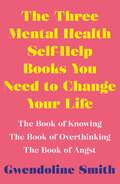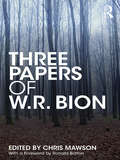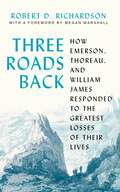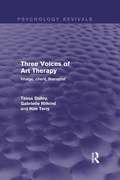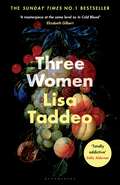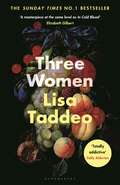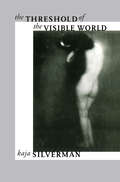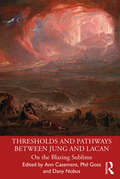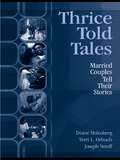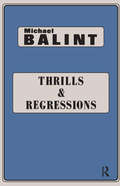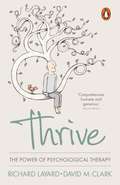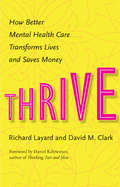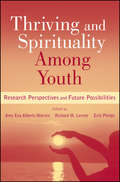- Table View
- List View
The Three Mental Health Self-Help Books You Need to Change Your Life: The Book of Knowing, The Book of Overthinking & The Book of Angst (Gwendoline Smith - Improving Mental Health Series)
by Gwendoline SmithDiscover the series from internationally bestselling author Gwendoline Smith on how best to manage mental health difficulties.Grounded in CBT, this collection of New Zealand psychologist Gwendoline Smith's bestselling mental-health self-help books offers practical, accessible advice for all the key areas of your life, helping you regain control over feelings of overwhelm (THE BOOK OF KNOWING), how to stop the cycle of worry (THE BOOK OF OVERTHINKING) and how to understand and deal with anxiety (THE BOOK OF ANGST).THE BOOK OF KNOWING: Written in an accessible and humorous style, this book teaches you to know what's going on in your mind and how to get your feelings under control. It'll help you adapt and feel better about your place in the world.THE BOOK OF OVERTHINKING: Overthinking is also known as worrying or ruminating and it's a form of anxiety that many people suffer from. This book explains in clear and simple language the concepts of positive and negative overthinking, the truth about worry and how to deal with the 'thought viruses' that are holding you back.THE BOOK OF ANGST: There's a lot of angst around these days. This heightened sense of fear, concern, insecurity and uncertainty can be overwhelming. This book explains what angst is and the ways in which deep anxiety can manifest, before drilling down into the often under-diagnosed but extremely common social anxiety.***Across all three books, Gwendoline's warm, accessible tone, smart advice and accompanying illustrations helps you better understand what's going on in your head, using humour, lots of examples and anecdotes, and offering powerful strategies for addressing your issues.
Three mountains task (Large Print)
by Rnib BookshareThis diagram shows the set up of the three mountains task. There is a locator dot shown, which will be at the top left of the page when the image is the right way up. In the top half of the page is a plan view of a model of the three mountains on a square table with each side labelled 1 to 4. Looking down on the table there is a large mountain at the 12 oclock position, shown as a large circle, a middle sized one down from this on the right, and a small one on the left from it. The lower half of the page shows the side views of the experiment. Here there are four diagrams each showing a different view of the three mountains model, as seen by looking directly at it from each side. From side 1 the large mountain is on the left, and on the right the small mountain is in front of the middle sized mountain. From side 2, the small mountain and the middle sized mountain can be seen in front with the large mountain behind and in between them. From side 3 only the middle-sized and large mountains can be seen, as the small mountain is behind the middle sized mountain and cannot be seen. From side 4, the large mountain can be seen in front, with the other two behind it, the middle sized one on the left, and the small mountain on the right.
Three mountains task (UEB Contracted)
by Rnib BookshareThis diagram shows the set up of the three mountains task. There is a locator dot shown, which will be at the top left of the page when the image is the right way up. In the top half of the page is a plan view of a model of the three mountains on a square table with each side labelled 1 to 4. Looking down on the table there is a large mountain at the 12 oclock position, shown as a large circle, a middle sized one down from this on the right, and a small one on the left from it. The lower half of the page shows the side views of the experiment. Here there are four diagrams each showing a different view of the three mountains model, as seen by looking directly at it from each side. From side 1 the large mountain is on the left, and on the right the small mountain is in front of the middle sized mountain. From side 2, the small mountain and the middle sized mountain can be seen in front with the large mountain behind and in between them. From side 3 only the middle-sized and large mountains can be seen, as the small mountain is behind the middle sized mountain and cannot be seen. From side 4, the large mountain can be seen in front, with the other two behind it, the middle sized one on the left, and the small mountain on the right.
Three mountains task (UEB Uncontracted)
by Rnib BookshareThis diagram shows the set up of the three mountains task. There is a locator dot shown, which will be at the top left of the page when the image is the right way up. In the top half of the page is a plan view of a model of the three mountains on a square table with each side labelled 1 to 4. Looking down on the table there is a large mountain at the 12 oclock position, shown as a large circle, a middle sized one down from this on the right, and a small one on the left from it. The lower half of the page shows the side views of the experiment. Here there are four diagrams each showing a different view of the three mountains model, as seen by looking directly at it from each side. From side 1 the large mountain is on the left, and on the right the small mountain is in front of the middle sized mountain. From side 2, the small mountain and the middle sized mountain can be seen in front with the large mountain behind and in between them. From side 3 only the middle-sized and large mountains can be seen, as the small mountain is behind the middle sized mountain and cannot be seen. From side 4, the large mountain can be seen in front, with the other two behind it, the middle sized one on the left, and the small mountain on the right.
Three Papers of W.R. Bion
by W.R. BionThree Papers of W.R. Bion features two previously unpublished papers and one which has only previously appeared in The Complete Works of W. R. Bion (2014). Characterised by Bion’s directness, clarity and intensity, together they illustrate important aspects of his later thinking. They also show Bion using his key ideas in fresh contexts which will allow readers already familiar with his theoretical and clinical concepts to appreciate them from a new angle. The first paper, Memory and Desire, clarifies one of Bion’s most important and clinically-relevant ideas: the value of suspending elements of our memory and desire in the service of allowing openness to psychoanalytic intuition. The second, Negative Capability, was reformulated to become the final chapter of his 1970 Attention and Interpretation. The publication here of the original paper allows an interesting and rewarding three-way comparison to be made with the 1970 chapter, and Memory and Desire. The third paper, Break Up, Break Down, Break Through, was presented without notes in 1976 in Los Angeles and the transcript from the recorded talk is published here for the first time. It displays the complex interweaving of the personal and the theoretical and offers a fascinating contribution to the study of what Bion called "the turbulence that obeys no man-made ‘laws of nature’". Wilfred R. Bion’s writing continues to be read and re-read by an increasing and widening readership; the three papers presented here possess contemporary clinical relevance and each have a bearing on the underlying philosophical basis of psychoanalytical work and thinking.
Three Papers of W.R. Bion
by W.R. BionThree Papers of W.R. Bion features two previously unpublished papers and one which has only previously appeared in The Complete Works of W. R. Bion (2014). Characterised by Bion’s directness, clarity and intensity, together they illustrate important aspects of his later thinking. They also show Bion using his key ideas in fresh contexts which will allow readers already familiar with his theoretical and clinical concepts to appreciate them from a new angle. The first paper, Memory and Desire, clarifies one of Bion’s most important and clinically-relevant ideas: the value of suspending elements of our memory and desire in the service of allowing openness to psychoanalytic intuition. The second, Negative Capability, was reformulated to become the final chapter of his 1970 Attention and Interpretation. The publication here of the original paper allows an interesting and rewarding three-way comparison to be made with the 1970 chapter, and Memory and Desire. The third paper, Break Up, Break Down, Break Through, was presented without notes in 1976 in Los Angeles and the transcript from the recorded talk is published here for the first time. It displays the complex interweaving of the personal and the theoretical and offers a fascinating contribution to the study of what Bion called "the turbulence that obeys no man-made ‘laws of nature’". Wilfred R. Bion’s writing continues to be read and re-read by an increasing and widening readership; the three papers presented here possess contemporary clinical relevance and each have a bearing on the underlying philosophical basis of psychoanalytical work and thinking.
The Three Pillars of Radicalization: Needs, Narratives, and Networks
by Rohan Gunaratna Arie W. Kruglanski Jocelyn J. BélangerWhat fuels radicalization? Is deradicalization a possibility? The Three Pillars of Radicalization: Needs, Narratives, and Networks addresses these crucial questions by identifying the three major determinants of radicalization that progresses into violent extremism. The first determinant is the need: individuals' universal desire for personal significance. The second determinant is narrative, which guides members in their "quest for significance." The third determinant is the network, or membership in one's group that validates the collective narrative and dispenses rewards like respect and veneration to members who implement it. In this book, Arie W. Kruglanski, Jocelyn J. Bélanger, and Rohan Gunaratna present a new model of radicalization that takes into account factors that activate the individual's quest for significance. Synthesizing varied empirical evidence, this volume reinterprets prior theories of radicalization and examines major issues in deradicalization and recidivism, which will only become more relevant as communities continue to negotiate the threat of extremism.
The Three Pillars of Radicalization: Needs, Narratives, and Networks
by Arie W. Kruglanski Jocelyn J. Bélanger Rohan GunaratnaWhat fuels radicalization? Is deradicalization a possibility? The Three Pillars of Radicalization: Needs, Narratives, and Networks addresses these crucial questions by identifying the three major determinants of radicalization that progresses into violent extremism. The first determinant is the need: individuals' universal desire for personal significance. The second determinant is narrative, which guides members in their "quest for significance." The third determinant is the network, or membership in one's group that validates the collective narrative and dispenses rewards like respect and veneration to members who implement it. In this book, Arie W. Kruglanski, Jocelyn J. Bélanger, and Rohan Gunaratna present a new model of radicalization that takes into account factors that activate the individual's quest for significance. Synthesizing varied empirical evidence, this volume reinterprets prior theories of radicalization and examines major issues in deradicalization and recidivism, which will only become more relevant as communities continue to negotiate the threat of extremism.
Three Roads Back: How Emerson, Thoreau, and William James Responded to the Greatest Losses of Their Lives
by Robert D. RichardsonFrom their acclaimed biographer, a final, powerful book about how Emerson, Thoreau, and William James forged resilience from devastating loss, changing the course of American thoughtIn Three Roads Back, Robert Richardson, the author of magisterial biographies of Ralph Waldo Emerson, Henry David Thoreau, and William James, tells the connected stories of how these foundational American writers and thinkers dealt with personal tragedies early in their careers. For Emerson, it was the death of his young wife and, eleven years later, his five-year-old son; for Thoreau, it was the death of his brother; and for James, it was the death of his beloved cousin Minnie Temple. Filled with rich biographical detail and unforgettable passages from the journals and letters of Emerson, Thoreau, and James, these vivid and moving stories of loss and hard-fought resilience show how the writers’ responses to these deaths helped spur them on to their greatest work, influencing the birth and course of American literature and philosophy.In reaction to his traumatic loss, Emerson lost his Unitarian faith and found solace in nature. Thoreau, too, leaned on nature and its regenerative power, discovering that “death is the law of new life,” an insight that would find expression in Walden. And James, following a period of panic and despair, experienced a redemptive conversion and new ideas that would drive his work as a psychologist and philosopher. As Richardson shows, all three emerged from their grief with a new way of seeing, one shaped by a belief in what Emerson called “the deep remedial force that underlies all facts.”An inspiring book about resilience and the new growth and creativity that can stem from devastating loss, Three Roads Back is also an extraordinary account of the hidden wellsprings of American thought.
Three Voices of Art Therapy: Image, client, therapist (Psychology Revivals)
by Tessa Dalley Gabrielle Rifkind Kim TerryThe image, the client and the therapist are three essential aspects of the art therapy relationship; each has a separate ‘voice’. In this book, originally published in 1993, the three voices come alive as the client, Kim, and the therapist, Gabrielle, tell the story of his path from suicidal despair to health and creativity through a series of extraordinary images. The images, chosen to represent the stages of Kim’s therapeutic experience, speak for themselves and convey their importance as a powerful catalyst for change. An outer voice, that of Tessa Dalley, provides a theoretical commentary on the process as it occurs, adding to the understanding of what is happening in the therapeutic encounter. This fully rounded account of clinical practice in art therapy offers a rare insight into common issues and dilemmas which will make the book of interest to both professional and non-professional readers alike.
Three Voices of Art Therapy: Image, client, therapist (Psychology Revivals)
by Tessa Dalley Gabrielle Rifkind Kim TerryThe image, the client and the therapist are three essential aspects of the art therapy relationship; each has a separate ‘voice’. In this book, originally published in 1993, the three voices come alive as the client, Kim, and the therapist, Gabrielle, tell the story of his path from suicidal despair to health and creativity through a series of extraordinary images. The images, chosen to represent the stages of Kim’s therapeutic experience, speak for themselves and convey their importance as a powerful catalyst for change. An outer voice, that of Tessa Dalley, provides a theoretical commentary on the process as it occurs, adding to the understanding of what is happening in the therapeutic encounter. This fully rounded account of clinical practice in art therapy offers a rare insight into common issues and dilemmas which will make the book of interest to both professional and non-professional readers alike.
Three Women: THE #1 SUNDAY TIMES BESTSELLER
by Lisa Taddeo'A masterpiece at the same level as In Cold Blood' ELIZABETH GILBERT'This is one of the most riveting, assured and scorchingly original debuts I've ever read. I can't imagine a scenario where this isn't one of the most important – and breathlessly debated – books of the year' DAVE EGGERS'Addictive, totally addictive. Brilliant' DOLLY ALDERTON'A fascinating excavation of the intricacies of love and desire, where they conspire and where they conflict. Read this book' ESTHER PEREL'Indescribably magnificent. You will LOVE it' MARIAN KEYES'My non-fiction book of the year. Astounding' JESSIE BURTON'This book – challenging and heartbreaking – will stay with me. An extraordinary, documentary deep dive into the psychology of women and sex that is as unputdownable as the most page-turning fiction' JOJO MOYESAll Lina wanted was to be desired. How did she end up in a marriage with two children and a husband who wouldn't touch her?All Maggie wanted was to be understood. How did she end up in a relationship with her teacher and then in court, a hated pariah in her small town?All Sloane wanted was to be admired. How did she end up a sexual object of men, including her husband, who liked to watch her have sex with other men and women?Three Women is a record of unmet needs, unspoken thoughts, disappointments, hopes and unrelenting obsessions.
Three Women: THE #1 SUNDAY TIMES BESTSELLER
by Lisa TaddeoThe International No. 1 Bestseller'Cuts to the heart of who we are' Sunday Times'A book that begs discussion' Vanity FairAll Lina wanted was to be desired. How did she end up in a marriage with two children and a husband who wouldn't touch her?All Maggie wanted was to be understood. How did she end up in a relationship with her teacher and then in court, a hated pariah in her small town?All Sloane wanted was to be admired. How did she end up a sexual object of men, including her husband, who liked to watch her have sex with other men and women?'I will probably re-read it every year of my life' Caitlin Moran'Will have millions nodding in recognition' The Times'As gripping as the most gripping thriller' Marian Keyes'When I picked it up, I felt I'd been waiting half my life to read it' Observer'The kind of bold, timely, once-in-a-generation book that every house should have a copy of, and probably will before too long' New StatesmanThe book Phoebe Waller-Bridge, Alexa Chung, Jodie Comer, Reese Witherspoon, Harry Styles, Fearne Cotton, Caitriona Balfe, Gwyneth Paltrow, Sharon Horgan, Zoe Ball, Rosie Huntington-Whiteley, Davina McCall, Gemma Chan, Christine and the Queens and Gillian Anderson are all reading
The Threshold of the Visible World
by Kaja SilvermanIn The Threshold of the Visible World Kaja Silverman advances a revolutionary new political aesthetic, exploring the possibilities for looking beyond the restrictive mandates of the self, and the normative aspects of the cultural image-repertoire. She provides a detailed account of the social and psychic forces which constrain us to look and identify in normative ways, and the violence which that normativity implies.
The Threshold of the Visible World
by Kaja SilvermanIn The Threshold of the Visible World Kaja Silverman advances a revolutionary new political aesthetic, exploring the possibilities for looking beyond the restrictive mandates of the self, and the normative aspects of the cultural image-repertoire. She provides a detailed account of the social and psychic forces which constrain us to look and identify in normative ways, and the violence which that normativity implies.
Thresholds and Pathways Between Jung and Lacan: On the Blazing Sublime
by Ann Casement Dany Nobus Phil GossThis groundbreaking book was seeded by the first-ever joint Jung–Lacan conference on the notion of the sublime held at Cambridge, England, against the backdrop of the 100th anniversary of the outbreak of the Great War. It provides a fascinating range of in-depth psychological perspectives on aspects of creativity and destruction inherent in the monstrous, awe-inspiring sublime. The chapters include some of the outcrop of academic and clinical papers given at this conference, with the addition of new contributions that explore similarities and differences between Jungian and Lacanian thinking on key topics such as language and linguistics, literature, religion, self and subject, science, mathematics and philosophy. The overall objective of this vitalizing volume is the development and dissemination of new ideas that will be of interest to practising psychoanalysts, psychotherapists and academics in the field, as well as to all those who are captivated by the still-revolutionary thinking of Jung and Lacan.
Thresholds and Pathways Between Jung and Lacan: On the Blazing Sublime
by Ann Casement Dany Nobus Phil GossThis groundbreaking book was seeded by the first-ever joint Jung–Lacan conference on the notion of the sublime held at Cambridge, England, against the backdrop of the 100th anniversary of the outbreak of the Great War. It provides a fascinating range of in-depth psychological perspectives on aspects of creativity and destruction inherent in the monstrous, awe-inspiring sublime. The chapters include some of the outcrop of academic and clinical papers given at this conference, with the addition of new contributions that explore similarities and differences between Jungian and Lacanian thinking on key topics such as language and linguistics, literature, religion, self and subject, science, mathematics and philosophy. The overall objective of this vitalizing volume is the development and dissemination of new ideas that will be of interest to practising psychoanalysts, psychotherapists and academics in the field, as well as to all those who are captivated by the still-revolutionary thinking of Jung and Lacan.
Thrice Told Tales: Married Couples Tell Their Stories
by Diane Holmberg Terri L. Orbuch Joseph VeroffResearchers have studied marriage for decades, but how is the transition to married life actually experienced by the couples involved? From an insider's perspective, Thrice Told Tales examines married couples' own stories of their relationship. A representative sample of 199 African-American and 177 White married couples were asked to tell the story of their relationship. It provides accounts of courtships, weddings, honeymoons, their adjustment in the early years, and hopes for the future. These stories were first collected a few months after their weddings, and again in the third and seventh years of their marriages. What features of their relationship do the couples highlight as central in the early years? How do their stories change over time? What can we learn about couples' marital well-being by analyzing their stories? How do the stories of men and women, and of White and African-American couples differ? These questions were systematically addressed using extensive coding schemes and comprehensive quantitative analyses. Details of the coding system and procedures are included, making this volume a useful reference for any researcher contemplating analysis of narrative data. However, the key points are also explained in simple prose and illustrated with quotes from the couples' own stories, making the book accessible to anyone with an interest in how young couples experience married life today.
Thrice Told Tales: Married Couples Tell Their Stories
by Diane Holmberg Terri L. Orbuch Joseph VeroffResearchers have studied marriage for decades, but how is the transition to married life actually experienced by the couples involved? From an insider's perspective, Thrice Told Tales examines married couples' own stories of their relationship. A representative sample of 199 African-American and 177 White married couples were asked to tell the story of their relationship. It provides accounts of courtships, weddings, honeymoons, their adjustment in the early years, and hopes for the future. These stories were first collected a few months after their weddings, and again in the third and seventh years of their marriages. What features of their relationship do the couples highlight as central in the early years? How do their stories change over time? What can we learn about couples' marital well-being by analyzing their stories? How do the stories of men and women, and of White and African-American couples differ? These questions were systematically addressed using extensive coding schemes and comprehensive quantitative analyses. Details of the coding system and procedures are included, making this volume a useful reference for any researcher contemplating analysis of narrative data. However, the key points are also explained in simple prose and illustrated with quotes from the couples' own stories, making the book accessible to anyone with an interest in how young couples experience married life today.
Thrills and Regressions
by Michael BalintContents: Part One - Thrills; Part Two - Regressions; Part Three: Appendix; Part Four - Conclusions. This book includes the paper "Distance in Time and Space" by Enid Balint.
Thrills and Regressions
by Michael BalintContents: Part One - Thrills; Part Two - Regressions; Part Three: Appendix; Part Four - Conclusions. This book includes the paper "Distance in Time and Space" by Enid Balint.
Thrive: The Power of Evidence-Based Psychological Therapies
by Richard Layard David M. ClarkA ground-breaking argument for better treatment of mental health from Richard Layard (author of Happiness) and David M. Clark.Britain has become a world leader in providing psychological therapies thanks to the work of Richard Layard and David Clark. But, even so, in Britain and worldwide the majority of people who need help still don't get treatment. This is both unjust and a false economy.This book argues for change. It shows that mental ill-health causes more of the suffering in our society than physical illness, poverty or unemployment. Moreover, greater spending on helping people to recover from mental health problems - and stay well - would generate massive savings to national economies, as those who suffer from depression and anxiety disorders account for nearly a half of all disability and are predominantly of working age. Modern talking therapies, such as CBT (Cognitive Behavioural Therapy), are highly effective, and if more sufferers got these treatments, lives would be turned around and the cost would be fully covered by the huge savings.Thrive explores the new effective solutions to the misery and injustice caused by mental illness. It describes how successful psychological treatments have been developed and explains what works best for whom. It also urges us to do all we can to prevent these problems in the first place, through better schools and a better society. And, most importantly, it offers real hope.'This book is an inspiring success story and a stirring call to further action. Its message is as compelling as it is important: the social costs of mental illness are terribly high and the costs of effective treatments are surprisingly low' Daniel Kahneman'Extremely easy and pleasurable to read. It's the most comprehensive, humane and generous study of mental illness that I've come across' Melvyn Bragg'Remarkable . . . presents the issues in a style that easy for the professional, the general public, and policy makers to understand' Aaron T Beck'Professors Layard and Clark (the Dream Team of British Social Science) make a compelling case for a massive injection of resources into the treatment and prevention of mental illness. This is simply the best book on public policy and mental health ever written' Martin SeligmanRICHARD LAYARD is one of the world's leading labour economists, and in 2008 received the IZA International Prize for Labour Economics. A member of the House of Lords, he has done much to raise the public profile of mental health. His 2005 book Happiness has been translated into 20 languages.DAVID M. CLARK, Professor of Psychology at Oxford, is one of the world's leading experts on CBT, responsible for much progress in treatment methods. With Richard Layard, he was the main driver behind the UK's Improving Access to Psychological Therapies programme.
Thrive: How Better Mental Health Care Transforms Lives and Saves Money
by Richard Layard David M. Clark Daniel KahnemanMental illness is a leading cause of suffering in the modern world. In sheer numbers, it afflicts at least 20 percent of people in developed countries. It reduces life expectancy as much as smoking does, accounts for nearly half of all disability claims, is behind half of all worker sick days, and affects educational achievement and income. There are effective tools for alleviating mental illness, but most sufferers remain untreated or undertreated. What should be done to change this? In Thrive, Richard Layard and David Clark argue for fresh policy approaches to how we think about and deal with mental illness, and they explore effective solutions to its miseries and injustices.Layard and Clark show that modern psychological therapies are highly effective and could potentially turn around the lives of millions of people at little or no cost. This is because treating psychological problems generates huge savings on physical health care, as well as massive economic savings through more people working. So psychological therapies would effectively pay for themselves, generating potential savings for nations the world over. Layard and Clark describe how various successful psychological treatments have been developed and explain what works best for whom. They also discuss how mental illness can be prevented through better schools and a better society, and the urgency of doing so.Illustrating why we cannot afford to ignore the issue of mental illness, Thrive opens the door to new options and possibilities for one of the most serious problems facing us today.
Thrive: How Better Mental Health Care Transforms Lives and Saves Money
by Richard Layard David M. Clark Daniel KahnemanMental illness is a leading cause of suffering in the modern world. In sheer numbers, it afflicts at least 20 percent of people in developed countries. It reduces life expectancy as much as smoking does, accounts for nearly half of all disability claims, is behind half of all worker sick days, and affects educational achievement and income. There are effective tools for alleviating mental illness, but most sufferers remain untreated or undertreated. What should be done to change this? In Thrive, Richard Layard and David Clark argue for fresh policy approaches to how we think about and deal with mental illness, and they explore effective solutions to its miseries and injustices.Layard and Clark show that modern psychological therapies are highly effective and could potentially turn around the lives of millions of people at little or no cost. This is because treating psychological problems generates huge savings on physical health care, as well as massive economic savings through more people working. So psychological therapies would effectively pay for themselves, generating potential savings for nations the world over. Layard and Clark describe how various successful psychological treatments have been developed and explain what works best for whom. They also discuss how mental illness can be prevented through better schools and a better society, and the urgency of doing so.Illustrating why we cannot afford to ignore the issue of mental illness, Thrive opens the door to new options and possibilities for one of the most serious problems facing us today.
Thriving and Spirituality Among Youth: Research Perspectives and Future Possibilities
by Amy Eva Alberts Warren Richard M. Lerner Erin PhelpsThriving and Spirituality Among Youth empirically explores the connections between spirituality and positive youth development through the research of a set of scholars from the wide array of scientific fields including biology, sociology, and theology. This unique handbook shows how to foster positive development during adolescence, including youth contributions to families and communities in civil society. The material draws on research conducted with various populations including immigrant Hispanic, Chinese, Israeli, and Muslim-American youth. Social workers and mental health professionals will find a new, developmentally rigorous data base for a science of "adolescent spirituality."
